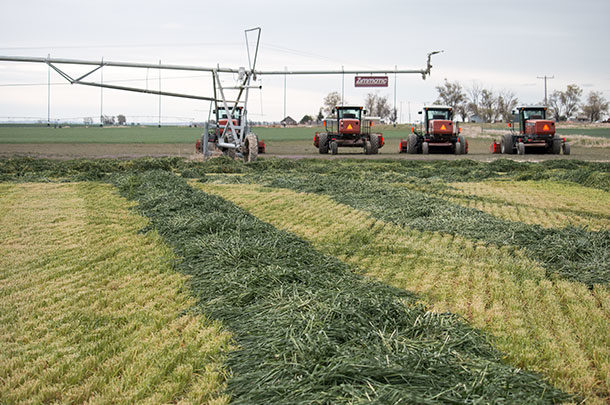Let’s look into each option.
Cereal rye
Cereal rye has home run potential. By that I mean cereal rye has the highest forage yield potential. Its aggressive, early growth results in consistent tonnage. However, the harvest window for cereal rye is narrow. It quickly turns mature, resulting in a loss of forage quality, palatability and feed value. Thus, while it has home run potential, harvest delays due to weather, mechanical failure or backed-up custom harvest crews can lead to a costly strikeout.
Cereal rye is the easiest to establish under stressful conditions. It is the best option for early spring grazing. Early turnout onto cereal rye can have several advantages. Feeding less hay, spreading less manure, improved calving environment over drylots and allowing permanent pastures to fully establish themselves prior to grazing are all obvious benefits.
The downside to grazing cereal rye is wet weather can dampen success. Poor field conditions or mismanagement of the grazing animals can result in soil compaction, loss of valuable forage to trampling and potential delays in getting the cash crop in the ground.
Triticale
Triticale has grown in popularity for those looking to mechanically harvest small grains. The biggest reason for increased use is the longer harvest window. Unlike cereal rye, triticale will mature less rapidly and subsequently allow more time to harvest high-quality forage. Planting a few more acres can adjust for slightly lower yields when compared with cereal rye. Triticale offers good forage yield with reliable forage quality.
If you get in a spot where an exit strategy is needed, triticale is easy to control. It does not volunteer like cereal rye. Thus, there are fewer issues as a weed in other crops. This may be very appealing to producers just starting out with small grains.
Wheat
Wheat has fallen out of many crop rotations for economic reasons. However, on some farms, wheat has made a comeback. It is a great tool for those farms focusing on soil health, those that need a place to go with manure and those that can sell the straw. Using winter wheat for spring forage is popular in the Southern Plains, where a more moderate winter climate allows some growth to continue at the end and start of the year. In the Midwest, where winter wheat goes dormant, the forage yields are poor, the grazing window is short and grazing often minimizes grain yield.
If harvested at flag leaf stage, feed quality can be good. If harvest is not timely, quality will be poor. Wheat allows an appealing exit strategy as it can be easily harvested for grain and the straw baled. This likely limits double crop opportunity and runs the risk of lowering income per acre.
Other things to keep in mind:
• Allelopathy – the release of chemicals by a plant that negatively impacts the growth of adjacent plants – can be a problem with corn following cereal rye. An easy solution is to plant soybeans following cereal rye. This pairing has been very successful. Triticale can also cause this, but normally is less severe. Total removal of forage helps reduce allelopathy.
• Weed potential in wheat. If wheat is in your rotation for grain or potentially will be, it is important to not allow cereal rye to mature and go to seed. Triticale doesn’t resent this challenge.
• Potential for pathogens and pests. A growing crop can provide a green bridge for plant pathogens and a habitat for pests. Some farmers have had issues with slugs and voles in fields with cover crops.
• Benefits in blends. Monoculture small grains may be the most popular for harvest forage; however, consider cover crop blends including small grains, brassicas, legumes and forbs to garner more benefits than just forage yield from your off-season crop. Consult your local extension specialist for seeding rate and planting dates.
In summary, growing another crop will add management challenges and increase time spent planning another harvest. However, these challenges and time commitments can be greatly rewarded with a high-quality forage crop that can complement your cattle feed needs. ![]()

-
Travis Meteer
- Extension Educator – Beef
- University of Illinois
- Email Travis Meteer
PHOTO: Triticale is easy to control and does not volunteer like cereal rye. It's an appealing option for producers just starting out with small grains. Photo by Lynn Jaynes.










